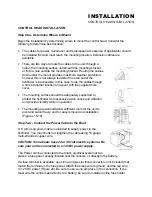
Fish ID
The Fish ID menu controls the method used to portray fish. There are
three selections available: ID Off, ID On, ID+. The factory setting is ID+.
With ID Off, sonar returns are displayed as "raw" information. There is no
interpretation made by the unit. Selecting ID Off will also disable the Fish
Alarm if selected.
ID On enables the Wide 128 to interpret the raw sonar data and using a variety of techniques, depicts
appropriate returns as one of three different size fish symbols.
Use the arrow buttons to highlight the desired setting.
USING DIAGNOSTIC
The Wide 128 contains a powerful diagnostic tool which can aid in
determining the cause of a problem. To enable Diagnostic, power the unit
on and use the DOWN ARROW button to highlight the Diagnostic option
on the initial screen. Diagnostic can only be accessed at power-up.
After the menu times out, the first of two diagnostic screens will appear.
Upon enabling diagnostic, the Wide 128 will perform a self-test. This test
confirms the operation of all internal circuitry. At the conclusion of the test,
one of two messages will appear; "passed" indicates that the internal test
discovered no failures. "Failed" indicates that a significant internal problem
was discovered and the unit will require factory service. In conjunction with
the failed indication will be a code which indicates to the repair personnel
where the problem is.
Press MENU to advance to the second Diagnostic screen.
The second Diagnostic screen shows transducer connection and voltage input.
The voltage
input category is especially helpful in diagnosing input voltage problems. The current input voltage will be
displayed. If voltage fluctuations or power supply in excess of 16 VDC or less than 10 DC is suspected,
use the diagnostic screen to confirm input voltage. Often, small outboard motors do not effectively
regulate voltage when operated at high engine speeds. Use Diagnostic while running the boat at high
speeds to show the voltage gain. Also, if you are using the Wide 128 in portable configuration or from the
trolling motor battery, Diagnostic can be used to evaluate the health of the battery by showing the current
volta
ge.
Summary of Contents for Wide 128
Page 1: ......

















